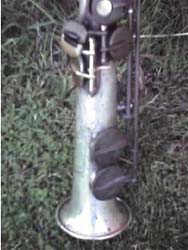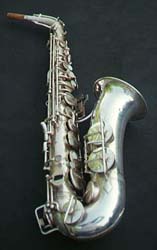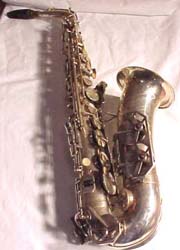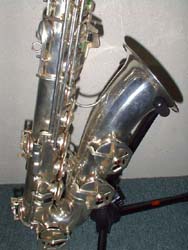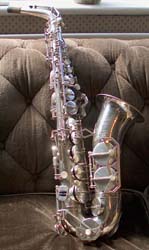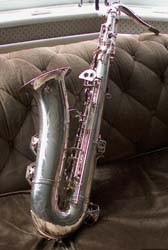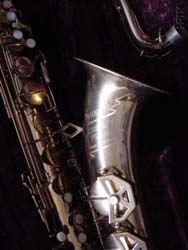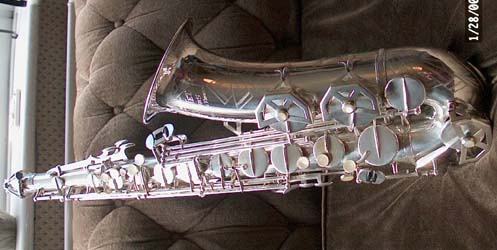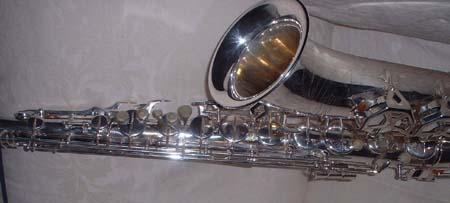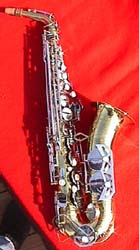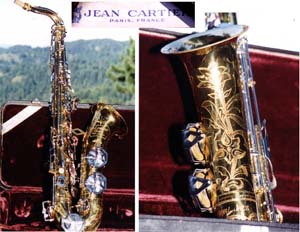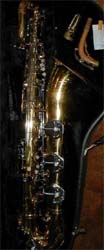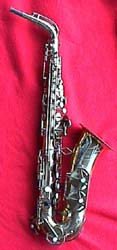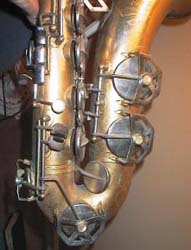 |
(1935 to 1984; s/n 0 thru 01xxx; earlier models not listed)
Website Home
|
Dolnet (pronounced DOL-NAY) is a model which has been getting steadily more popular since I started this website. There is a good reason for this: the horns are solidly made, are quite jazzy and have a fairly good sound, although there are some negative comments here and there regarding intonation. There isn't a Dolnet model or serial number chart, per se, so I essentially am creating this based on engravings, user input and manufacturing differences. As far as real Dolnet history goes, Dolnet was founded in 1880 and started manufacturing saxophones around 1888. I'm going to let guest columnist Laurie Pimblett take it from here (his commentary will always be in RED. Quotations from other sources are in BROWN): Over the years I've been exclusively collecting
French saxes. Along the way I've made a small collection of Dolnets;
these I regard as unknown treasures of the sax world, and I rate
them very highly indeed. They are often good -- sometimes breathtaking
-- and rank amongst the best saxes I've ever played! ... and the quoted and requoted line that's
going around the Internet (this is Wichita Band Instruments' version): IMHO, it appears that Dolnet production parallels Buffet, SML and Couesnon production, more than Selmer: not only is the keywork design on early Dolnets similar to early SML's (and becomes similar to Buffet after about 1940), some of the Jean Cartier stencils have the beautiful Sparkle Lacquer that is most famously found on the Buffet Super Dynaction. The overall look is definitely influenced by (or influenced) Couesnon horns. All this makes me agree with David Hughes (an e-mailer): the Dolnets were produced until at least the mid-1980's, not the 1960's as many websites indicate (see also Saxophon-Service, which advocates an end date of 1984). As mentioned, there isn't an official serial number list, although there are some ranges cobbled together, below. It seems, however, that the serial number ranges incorporate the full production of ALL instruments produced by Dolnet, not just saxophones. I'd think that production of saxophones was no more than 500 horns per year. Also note that the "Bel Air" series introduced letters after the serial number. If you see a "C" after the serial number, it isn't a C instrument! As always, if you have further information or pictures, please contact me at saxpics@gmail.com. |
|
Series I
(s/n ? to 12xx; 1935 to 1940) |
||
|
If it is true that the first Dolnet saxophones were produced in 1888, these are definitely not the first saxophones that Dolnet produced, but are the earliest I've been able to find. It is possible that, like Buffet, their serial number chart has changed a couple of times. Based on these horns' keywork, I would estimate they were made in the mid- to late-1930s. |
||
|
Series II
(s/n 12xx to 34xxx; 1940 to 1950) |
||||
|
More from Mr. Pimblett: [The pictures from Sax'Melody are from] I think, a French guy who just wanted the world to see the progress he was making in his restoration of an earlier Dolnet tenor; it's a gorgeous sax and I would love to get my hands on it. It has a simple bellbrace, and instead of pearls on the keyguards it looks to have red glass or garnet -- perhaps even red amber -- which was certainly popular with the top-class British and American fishing reel manufacturers as a hardwearing and semi-precious bearing material and decoration back in the '20s -'40s. There also appears to be an "intermediate" horn in this series without these "gems", or it could just be that Dolnet wanted to change things for a year or two. The later horns in this series switch to the "diamond" bell to body brace which is found on virtually all later Dolnets. |
||||
|
Bel Air Series
(s/n 34xxx to 80xxx; 1950 to 1970) |
||||
|
My Dolnet tenor is, I think, a
Belair model, but in silver. It's a big bore sax with the typical hexagonal
'Art Deco' touches to the side keys, the crook ferrule and the C/Eb
cluster. The LH thumb-rest is a round pearl, as are the centres on the
geometric keyguards. The crook-cork collar is rolled, like Selmer's.
Keywork is (apart from the superb Dolnet octave system) otherwise conventional. Engraving is quite distinctive:
elaborate concentric geometic scrolling, all emanating from what might
be called a central 'cartouche' -- I think the artist was strongly influenced
by the patterns in the magnetic field! The overall effect is stunning. [The "Bel Air" model
name is based on] a conversation I had
with an old guy back a few years ago: he had a Bel Air tenor identical
to mine, though of a slightly earlier ser. no. (within a few hundred).
He bought it new in Paris back in the late 40's (though he couldn't
be certain exactly when). My alto, which came from the same source,
matches my tenor closely but again is not marked "Bel Air". My 395** tenor is probably younger
by a year or two. These horns are virtually identical to the Imperial model (listed below). It's possible that Dolnet actually labelled these horns "Bel Air" for a few years, labelled them "Imperial" for a few years and then decided not to label them anything at all. |
||||
|
Imperial Models
(s/n 40xxx to 45xxx; 1952 to 1953) |
||
|
Please see the comments on the Bel Air series horns, above. It's possible that these horns were only available for
this thin serial number range. |
||
|
M70 Models
(s/n 80xxx to 00000; 1970 to 1980) |
|
s/n
834xx
Thanks to Laurie Pimblett Silver Plate |
|
Next comes something rather special,
my M70 (model name engraved on the bell).
This I got from a European dealer who listed it as "a beginner's
horn ... very difficult to play". I got it for very little. It hasn't got the big sound of its older brothers, but it is one of the sweetest and most clear-voiced classical tenors I've ever played. Just recently I performed a Haydn duet with harpsichord/electric keyboard, and the audience was ecstatic about the sound: it plays the most controlled pianissimos of any of my saxes and has a lightning-fast action. Again, it has pearl touches to
the keyguards which are typically Dolnet art-deco, though the engraving
is quite different: this time in very beautiful series of straight and
zigzagged lines in true deco style. Ser. no. 834** places it very late, possibly 1969-70. I also know that my M70 's original and battered case is one which was in production in the late 60's -- I actually remember them being sold. (Purely speculatively: could M70 stand for 'Modele (19)70'? Some manufacturers start off a new decade with a new model [e.g. the Mark VII and Super 80]. If it is true that the case is from the late 60's and this horn was only produced in the early 1970's, this might explain the extreme rarity of the sax, the significant departures from earlier Dolnet keywork and the dramatic lefthand angle on the bell.) The horn also has a redesigned G#/C#/B/Bb cluster, more "rounded" (i.e. not "Art Deco") keys and "Selmeresque" lower keyrods. If you accept my theory that Dolnet borrowed heavily from Buffet design, this horn looks an awful lot like a combination of a Buffet Super Dynaction or S1 and a Buescher 400 "Top Hat and Cane". |
|
Universal Models
(s/n 00000 to 01xxx?; 1980 to 1984) |
|
s/n
unknown
Thanks to David Hughes Silver Plate |
|
These are a slightly less elaborate version of the M70: it doesn't have an offset bell and has different engraving, but otherwise appears identical to the previous model. I have heard of altos and sopranos in this serial number range. As far as I have been able to determine, this is the last model Dolnet. If the M70 was introduced in1970, I see no reason not to believe that these horns were introduced in 1980. |
|
Jean Cartier Stencils
("Bel Air" Stencil) |
||||
|
These are one of the few stencils I've ever seen that actually have MORE features than the horn they were stencilled from There are at least two models of these horns: "The Royal Jazz Model", which sometimes has additional keywork (altissimo D# trill, G# trill, etc.), rolled tone holes and a microtuner neck, a la Conn and one sometimes labeled "Artist Model" that generally doesn't have all the additional stuff, but is striking, nonetheless. As mentioned in the introduction, these models sometimes have been done in Sparkle Lacquer, like some Buffet Superdynactions. I've now seen two of these models, so I doubt that these horns were relacquers. |
||||
|
Jules Revan Stencil
("Imperial" Stencil) |
La Chambre Stencil
("Bel Air" Stencil) |
|
|
Please see the comments on the Bel Air and Imperial series horns, above. |
||
|
Dolnet Resources at SOTW (archive board is in red)
|
| Donate to the Vintage Saxophone Gallery Website | ||
|
|
||
Website copyright © 1997-2006 by Pete Hales.
Pictures/sounds/etc. used herein may have their own copyright and most are used by permission.
If you feel any image or soundbyte used here is in violation of copyright or for information regarding use/reproduction of this website's content, please e-mail saxpics@gmail.com
Comments, corrections, suggestions or picture submissions: saxpics@gmail.com
